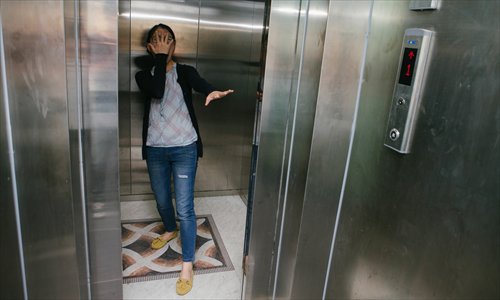Aging elevators in Beijing pose a greater security risk for passengers

People should be alert and look for safety signs when riding in elevators. Photo: Li Hao/GT
Almost two months after the incident, 27-year-old Guo Jing (pseudonym) still remembers how her heart pounded with fear when she got stuck in an elevator.
She was heading to the first floor from the 15th floor of her friend's apartment when the incident occurred.
"I broke into a cold sweat from fear when the elevator's door didn't open on the first floor. I pressed the emergency button for help," Guo recalled. "Then it suddenly went up to the third floor. When the door opened, I rushed out."
In Beijing, about 196,000 elevators take riders to and fro on a daily basis. However, with their eyes glued to their phones or minds on the task ahead, most riders are oblivious to the possibility of getting stuck.
Recently, the Beijing Municipal Administration of Quality and Technology Supervision released the results of a survey that tested high-risk elevators in the city. According to the survey, 94 percent of the 3,053 elevators evaluated failed the safety test.
The results attracted much public attention - the overarching question, "Why are so many elevators unsafe?"
Zhang Dihua, the director of the investigation and procedure affairs division of the Beijing Special Equipment Inspection and Testing Center, which is responsible for all elevator safety checks and maintenance in Beijing, partly attributed the figures to aging.
Li Zhanzhong, an employee at an elevator maintenance company in Beijing, shared Zhang's opinion. He told Metropolitan that once an elevator has been operating for more than eight years, it can be considered as aging and is easier to malfunction.
According to the Beijing Municipal Administration of Quality and Technology Supervision survey, about 54,000 elevators in Beijing can be put into this category, and more than half of them are in residential communities.
As to how to distinguish safe elevators, Zhang said that a sign verifying that the elevator has passed the annual safety check is usually posted inside. He encouraged riders to check for the sign and avoid taking elevators without one.
As for how to cope with elevators' stalling, Zhang cautioned riders from panicking when an elevator suddenly stops.
According to him, it is a sign of safety. "It's not malfunction, but a protection mechanism," he said.
To all the would-be heroes, Zhang warned against "improper" attempts to rescue themselves or others from a stopped elevator.
"It's more dangerous," he said. "People who get stuck in a stopped elevator should never force the door open or try to escape from the top of the elevator cab."
Even in a safe and well-maintained elevator, it is suggested that riders refrain from misbehaving to reduce the risk of malfunction, said Zhang.
"People should not press the elevator buttons too hard, use their hand, or other obstacles, to hold the elevator doors open, lean on the doors, smoke, or jump inside the machines," he said.
Zhang said when riders get stuck in an elevator, they should call emergency personnel, stay still and not waste energy.
"Keeping calm is the most important thing," he said.
Newspaper headline: Boxed in